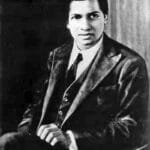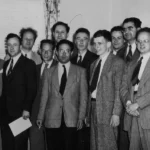ohn Nash’s brilliance transcended the boundaries of mathematics, impacting fields from economics to cryptography, and forever changing our understanding of human behavior. While “A Beautiful Mind” brought John Nash’s story to the masses, it only scratched the surface of a life marked by equally profound intellectual triumphs and personal battles.
Captivating Facts about John Nash
John Nash, the brilliant mathematician who inspired the film “A Beautiful Mind,” led a life as remarkable as the complex equations he unraveled. Let’s delve into some intriguing insights about this enigmatic figure.
1. Triumph Over Adversity
Imagine being diagnosed with schizophrenia, a mental illness often associated with a decline in cognitive abilities. Now, picture this: John Nash, facing this very challenge in his late 20s, chose to manage his condition without relying on medication for a significant period. This incredible feat speaks volumes about his resilience and determination.
2. The Collaborative Genius
Contrary to the stereotypical image of a lone genius toiling away in isolation, Nash flourished in collaborative environments. His time at Princeton University stands as a testament to how shared intellectual exploration can spark extraordinary breakthroughs. Nash’s story reminds us that even the most brilliant minds can benefit from the synergy of shared ideas.
3. A Legacy Beyond Numbers
While renowned for his contributions to mathematics, Nash’s work extended its reach far beyond theoretical equations. His ideas have left an indelible mark on diverse fields such as economics, evolutionary biology, and even the rapidly evolving world of artificial intelligence. To learn more about the impact of another brilliant mind, read up on some facts about Katherine Johnson and her incredible contributions to NASA. It’s a testament to the wide-ranging power of mathematical thinking.
4. The Real “Beautiful Mind”
The acclaimed film provided a glimpse into Nash’s life, but like any cinematic portrayal, it offered only a partial perspective. In reality, John Nash was a multifaceted individual. In his youth, he was known for his playful pranks. Later in life, he embraced the roles of a loving husband and dedicated father. To gain a deeper understanding of captivating figures, delve into these facts about Bill Clinton that shed light on his presidency and personal journey.
5. Secrets Hidden for National Security
Nash’s brilliance found a practical outlet in the realm of cryptography, where his groundbreaking work remained shrouded in secrecy for decades. This classified contribution underscores his significant role in safeguarding national security, hinting at a layer of his life that remained largely hidden from public view.
6. Reshaping Our Understanding of Strategy
Nash’s concept of “Nash Equilibrium” revolutionized the field of game theory, sending ripples through disciplines like economics and political science. This groundbreaking idea provided a framework for understanding strategic decision-making in situations where multiple players interact, influencing how we analyze everything from market competition to international relations.
7. A Rare Accolade, Twice Earned
John Nash’s exceptional contributions didn’t go unnoticed. He was honored with not one but two prestigious awards: the Nobel Prize in Economics and the Abel Prize in Mathematics. This rare feat places him among an elite group of intellectuals whose work has profoundly impacted multiple fields. Discover the captivating life of Robert Brown, a pioneering botanist, through these fascinating facts about Robert Brown that highlight his groundbreaking contributions to science.
8. A Mathematical Prodigy
At the age of 21, when many are still navigating the complexities of early adulthood, Nash had already made his mark on the world of mathematics. His doctoral dissertation on game theory, published at this remarkably young age, hinted at the extraordinary intellect that would leave an enduring legacy.
9. An Enduring Love Story
Behind every great mind, there’s often a source of unwavering support. For John Nash, this came in the form of his wife, Alicia. Her unwavering love and commitment shone through as she stood by him through his battle with schizophrenia. Their story reminds us of the profound power of love and companionship in navigating life’s most challenging chapters.
10. The Embodiment of Perseverance
John Nash’s life story serves as a powerful testament to the resilience of the human spirit. Despite facing profound challenges, he never relinquished his passion for intellectual exploration. His journey reminds us that brilliance and triumph can emerge even in the face of adversity, inspiring us to embrace challenges with courage and determination.
What are some interesting facts about John Nash?
So, we’ve talked about John Nash’s incredible work in mathematics. But did you know that his life was full of fascinating twists and turns that went way beyond equations and theorems? Let’s dive into some of the lesser-known aspects of this remarkable man.
For starters, John wasn’t just smart – he was practically a math prodigy. It’s said that before he even stepped foot in college, he was already playing around with advanced mathematical concepts that would make most people’s heads spin. Talk about a head start!
And speaking of groundbreaking, we can’t forget about his famous Nash Equilibrium. Imagine trying to figure out the best strategy in a game where everyone is trying to outsmart each other. Sounds tricky, right? Well, Nash’s theory provided a way to analyze these complex situations and predict what might happen, revolutionizing the field of game theory.
But John’s talents didn’t stop there. He also delved into the world of partial differential equations, some seriously high-level math that earned him yet another prestigious award, the Abel Prize. It’s like winning an Oscar for mathematicians!
What’s even more impressive is that Nash made significant contributions to cryptography, the art of secret codes. During the Cold War, when tensions were running high, his expertise was sought after to help keep sensitive information under wraps. Talk about a real-life math hero!
Sadly, John’s life wasn’t without its challenges. He battled with schizophrenia for many years, a condition that can distort thoughts and perceptions. However, even with this immense struggle, his passion for knowledge never faded. He continued to explore the world of mathematics, proving the incredible resilience of the human spirit.
Remarkably, even after facing such adversity, Nash returned to the world of academia later in life. He picked up right where he left off, pushing the boundaries of mathematical understanding and inspiring a whole new generation of mathematicians.
Tragically, John Nash and his wife, Alicia, were killed in a car accident in 2015. Their untimely deaths served as a stark reminder of life’s fragility, but Nash’s legacy continues to shine brightly.
John Nash’s story isn’t just about numbers and formulas; it’s about the power of the human mind to overcome obstacles and make sense of the world around us. His theories continue to influence our understanding of everything from human behavior and economics to the development of artificial intelligence. This cements his place as one of the most influential mathematicians of our time. It’s safe to say his work will likely continue to be studied and debated for generations to come.
How would you describe John Nash?
John Nash was a complex and brilliant individual who left an indelible mark on the world, despite facing extraordinary challenges. His life was a testament to the power of the human spirit to persevere and achieve greatness, even in the face of adversity. He was a true original.
What Did John Nash Struggle With?
John Nash, the mathematical genius portrayed in the movie “A Beautiful Mind,” faced a tough challenge: paranoid schizophrenia. This illness took a toll on his life in many ways.
Imagine seeing and hearing things that aren’t real, that’s what Nash went through. These hallucinations, coupled with delusions – beliefs that weren’t based in reality – made his world incredibly confusing. Sometimes, these delusions involved grand ideas and a sense of paranoia, making it difficult for him to trust those around him.
On top of that, his thoughts often became jumbled, making it hard for him to express himself clearly or think straight. This disorganization could spill over into his social life, sometimes leading to isolation. It’s hard to connect with others when your mind plays tricks on you.
Think about how frustrating it would be to have your greatest strength hampered by illness. Nash’s schizophrenia often overshadowed his incredible mathematical abilities, causing periods where he couldn’t work or study. The illness created a constant push and pull between his genius and his struggles.
However, Nash’s story wasn’t defined by his illness alone. With incredible willpower and the unwavering support of his wife, Alicia, he embarked on a path of recovery. Through a combination of therapy, medication, and his own inner strength, he gradually regained control over his mind. It was a long and difficult journey, but Nash’s story reminds us that even in the face of immense challenges, hope and recovery are possible. His life serves as an inspiration, proving that the human spirit can overcome even the most daunting obstacles.
What Did John Nash Actually See?
We’ve been talking about John Nash, the brilliant mathematician who won a Nobel Prize. Sadly, he also lived with paranoid schizophrenia, a condition that caused him to experience some pretty intense hallucinations. Just imagine seeing things so vividly that you’d swear they were real, but no one else could see them – that was John Nash’s reality.
These weren’t just fleeting shadows or blurry figures, either. He described seeing people with incredible detail, as if they were standing right there. It’s almost like his mind was creating these incredibly realistic images, distinct from the real people in his life. Not only that, but he would hear voices, too. Sometimes they’d try to talk to him, even accusing him of things or giving him instructions. There were times when these voices became quite menacing, you know, actually threatening him.
What’s really fascinating is how these hallucinations, as unsettling as they were, ended up influencing his work in mathematics, especially in ways you wouldn’t expect. It’s almost paradoxical – this really difficult experience somehow fueling his groundbreaking work.
Nash’s story is a complex one. Schizophrenia posed immense challenges in his life, affecting his relationships and his career. There were periods of isolation and setbacks that he had to overcome. But here’s the thing: despite all of that, he still made remarkable contributions to the world of mathematics, particularly in game theory. It’s no wonder he was awarded the Nobel Prize in Economics in 1994 – a true testament to his resilience and brilliance.
What we can learn from John Nash is that the human spirit is incredibly strong. His story reminds us that even in the face of severe mental illness, people can achieve extraordinary things. And more importantly, it prompts us to think about the nuanced relationship between genius and mental illness. It’s a complex issue that deserves our attention and understanding.
- Crypto Quotes’ Red Flags: Avoid Costly Mistakes - June 30, 2025
- Unlock Inspirational Crypto Quotes: Future Predictions - June 30, 2025
- Famous Bitcoin Quotes: A Deep Dive into Crypto’s History - June 30, 2025
















